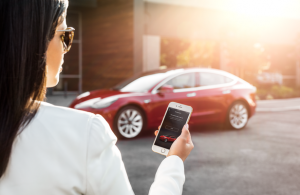Top speed in the Porsche Taycan electric sport sedan arrives with very little fuss on Germany’s autobahn. When the left lane clears just north of Hamburg, I mat the pedal and the white Turbo S—its profile reminiscent of a stretched 911, atop matching white 21-inch wheels—glides along as the speedometer needle tries to keep pace.
The Taycan moves with the thrust of an electric railgun, catching passengers and even drivers off guard with its seemingly unrestrained energy. But shocking as the launch can be—the more powerful Turbo S variant will reach 60 mph in just 2.6 seconds—the smooth highway offers little to upset the suspension. By 120 mph, I can feel the slipstream pushing me down, with no audible turbulence. That’s a result of the 0.22 drag coefficient, the best ever from Porsche, and more slippery than a Tesla Model 3. By 140 mph, just I’m expecting biblical-level wind noise and tire roar, the cabin’s vibe is surreal calm. At 160 mph, even the cars up ahead feel like they’re somehow already behind me. And still, the Taycan Turbo S, with its outrageous 750 horsepower (overboosted from the standard Turbo’s 616) and 774 pound-feet of torque, remains ready to do more.
Get the top electric car news in your inbox every Monday. Sign up here!
At the electronically limited top end of 162 mph, I take a moment to reflect. This and other performance EVs that will follow from Porsche and elsewhere—already in even faster and sleeker hypercar guises as prototypes from Lotus, Pininfarina, Rimac, Tesla, and more—are the way forward. My only wish at the moment: another 35 mph, or however much it would take to make this floating ghost of a car feel at least a little bit challenged. Eventually, I’m sure, we’ll all grow to love that slippery easiness and that masterful grace. And it’s worth noting the Taycan is a sport sedan, not a proper sports car. That’s in the future for Porsche, and it will presumably be more aggressive and visceral.
But with the Taycan, a central dilemma remains: It doesn’t feel as much like a classic Porsche as I’d hoped it would. Of course, things like the sound are different given the dismissal of the internal combustion engine—and I happen to love the electronically amplified whirr from the dual permanent magnet synchronous electric motors. But Porsches have always felt a bit on the edge, like they’re working. They communicate with their riders through vibrations in the pedals, seat, and steering wheel, generating feel as much as sound and movement. In the Taycan, I feel a bit detached. Along for the ride. The car is effortless. It hovers easily through twistier roads, but it doesn’t truly excite until I near the edge of adhesion and performance. And there, the computer puts a ceiling on the fun.
Such is the trade-off for driving the most advanced car in the world. Yes, Tesla has Autopilot, but that pseudo-self-driving system is arguably premature, and Elon Musk’s cars are built to standards below those of the more accomplished, old-dog carmakers. And yes, countless machines can go faster than 162 mph—Bugatti’s Chiron just hit 305—but few vroom with the insouciance of the Taycan, a testament to Porsche’s holistic design and engineering process. Nor does their technology truly stack up: Everything about the Taycan has been honed to performance perfection on the twists and straights of test tracks. The powertrain is a work of automotive art.
Porsche has equipped the Taycan with two powerful electric motors—a rare two-speed EV transmission mated to the rear motor, allowing for brisker acceleration and a higher top speed—and a 93.4-kWh battery built into the floor of the chassis. The 800-volt power system maintains consistent performance where other EVs start to flag after repeated high-speed driving. It speeds up charging too. The Taycan is capable of up to 270 kilowatts of DC fast charging, and on my drive I managed to get to 80 percent charge in less than 20 minutes at one of the Ionity DC chargers distributed across Europe. After an autobahn burst, I pulled in with just 1 percent charge left, but the aggressive driving actually helps charging. Increased temperatures also speed charging.
All that battery does make it a heavy car, however, at 5,100 pounds. While the capable motors and the tight suspension mask the weight well, the Taycan tends to plow into corners if you wait too long to get on the brakes. I felt the mass most acutely, though, when I crested a dipsy-do at inappropriate speed somewhere in rural Denmark, and bottomed out on the other side.
Braking—the thing that might have saved me from said body slam—presents another point for Porsche to diverge from the established EV playbook. Most manufacturers pile on the regenerative braking, using the electric motors to slow the car every time you lift off the throttle, pumping charge back into the batteries. This enables allows for single-pedal driving. The Taycan instead coasts when you release the throttle, and only offers regenerative braking integrated into the conventional disk braking. The idea is that it delivers the feel performance drivers have come to expect—either you’re slowing down via the pedal or you’re coasting. Porsche estimates that 90 percent of pedal braking still uses recuperative technology. Still, it’s sure to disappoint the many EV drivers who love the ability to get around with the one pedal.
Of course, most EV fans won’t be looking to drop $150,900, the starting price for the base Turbo, let alone the $185,000 for the Turbo S. This is a Porsche, and as such prioritizes performance over the preferences of the average EV buyer. Its interior is 100 percent on brand—tight, supportive, smartly designed, with a multiscreen infotainment setup that provides and optional passenger-only display—and its exterior is stylish and sexy. It’s the most expensive EV on the market right now. It’s also the best.
More Great WIRED Stories
- Why are rich people so mean?
- How cities reshape the evolutionary path of urban wildlife
- The iOS 13 privacy and security features you should know
- The “smart kitchen” is very stupid
- Artificial intelligence confronts a “reproducibility” crisis
- 👁 How do machines learn? Plus, read the latest news on artificial intelligence
- 🏃🏽♀️ Want the best tools to get healthy? Check out our Gear team’s picks for the best fitness trackers, running gear (including shoes and socks), and best headphones.


